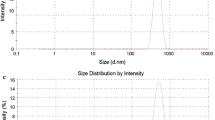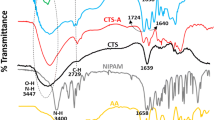Abstract
The objective of the present study was to synthesize and evaluate the effect of change in concentration of chitosan (CS) and N,N-methylenebisacrylamide (MBA)- a cross linking agent, on various properties such as lower critical solution temperature (LCST), zeta potential, particle size and poly dispersity index (PDI) of the synthesized co-polymer. Nine different formulations of chitosan-g-poly (N-isopropylacrylamide) (CS-g-PNIPAAm) co-polymer with varying CS and MBA concentrations were synthesized by a surfactant free dispersion copolymerization method. The synthesized co-polymer was further characterized and confirmed for its structure, morphology, particle size, zeta-potential, thermo and pH responsive properties, in-vitro cyto-compatability and stability studies using various analytical tools. The data confirms the successful synthesis of co-polymer. The increase in the concentrations of CS and MBA during the polymerization of co-polymer, resulted in proportional increase of LCST and zeta potential with decrease in particle size of co-polymeric nanoparticles. pH responsive studies showed that as the pH of the medium increases particle size and zeta potential decreases with increase in LCST of co-polymeric nanoparticles. From the results, it can be inferred that the synthesized co-polymeric nanoparticles exerted thermo and pH responsive properties with biocompatibility. By varying the CS and MBA concentrations in the co-polymer, desired LCST, particle size and zeta potential for co-polymeric nanoparticles can be obtained and thus the synthesized co-polymer may have great potential to be used as a drug carrier (nanoform) with both thermo and pH responsiveness.










Similar content being viewed by others
References
Recillas M, Silva LL, Peniche C, Goycoolea FM, Rinaudo M, Argüelles-Monal WM (2009) Thermoresponsive behavior of chitosan-g-N-isopropylacrylamide copolymer solutions. Biomacromolecules 10:1633–1641
Han J, Wang K, Yang D, Nie J (2009) Photopolymerization of methacrylated chitosan/PNIPAAm hybrid dual-sensitive hydrogels as carrier for drug delivery. Int J Biol Macromol 44:229–235
Al-Manasir N, Zhu K, Kjøniksen AL, Knudsen KD, Karlsson G, Nyström B (2009) Effects of temperature and pH on the contraction and aggregation of microgels in aqueous suspensions. J Phys Chem B 113:11115–11123
Pelton R (2010) Poly(N-isopropylacrylamide) (PNIPAM) is never hydrophobic. J Colloid Interface Sci 348:673–674
Chuang CY, Don TM, Chiu WY (2009) Synthesis of chitosan-based thermo- and pH-responsive porous nanoparticles by temperature-dependent self-assembly method and their application in drug release. J Polym Sci Part A 47:5126–5136
Zhang X, Zhuo R, Cui J, Zhang J (2002) A novel thermo-responsive drug delivery system with positive controlled release. Int J Pharm 235:43–50
Lin CL, Chiu WY, Lee CF (2005) Preparation of thermoresponsive core-shell copolymer latex with potential use in drug targeting. J Colloid Interface Sci 290:397–405
Li F, Wu H, Zhang H, Li F, Yang TH, Gu CH et al (2008) Novel super pH sensitive nanoparticles responsive to tumor extracellular pH. Carbohydr Polym 73:390–400
Li F, Wu H, Zhang H, Gu CH, Yang Q (2009) Antitumor drug paclitaxel loaded pH-sensitive nanoparticles targeting tumor extracellular pH. Carbohydr Polym 77:773–778
Cunxian D, Dianrui Z, Feihu W, Dandan Z, Lejiao J, Feifei F et al (2011) Chitosan-g-poly(N-isopropylacrylamide) based nanogels for tumor extracellular targeting. Int J Pharm 409:252–259
Rejinold NS, Sreerekha PR, Chennazhi KP, Nair SV, Jayakumar R (2011) Biocompatible, biodegradable and thermo-sensitive chitosan-g-poly (N-isopropylacrylamide) nanocarriers for curcumin drug delivery. Int J Biol Macromol 49:161–172
Zhang T, Li G, Guo L, Chen H (2012) Synthesis of thermo-sensitive CS-g-PNIPAM/CMC complex nanoparticles for controlled release of 5-FU. Int J Biol Macromol 51:1109–1115
Zhao SP, Zhou F, Li LY (2012) pH- and temperature-responsive behaviors of hydrogels resulting from the photopolymerization of allylated chitosan and N-isopropylacrylamide, and their drug release profiles. J Poly Res 19:9944
Tejabhiram Y, Shivaraman R, Gopalakrishnan C, Isaac M, Helen AT, Ramasamy C (2015) Dual responsive PNIPAM–chitosan targeted magnetic nanopolymers for targeted drug delivery. J Magn Magn Mater 380:315–320
Yuan H, Li B, Liang K, Lou X, Zhang Y (2014) Regulating drug release from pH- and temperature-responsive electrospun CTS-g-PNIPAAm/poly(ethylene oxide) hydrogel nanofibers. Biomed Mater 9:055001
Fan J, Chen J, Yang L, Lin H & Cao F (2009). Preparation of dual-sensitive graft copolymer hydrogel based on N-maleoyl-chitosan and poly(N-isopropylacrylamide) by electron beam radiation. Bull Mater Sci 32(5):521–526.
Chuang CY, Don TM, Chiu WY (2011) Preparation of environmental-responsive chitosan-based nanoparticles by self-assembly method. Carbohydr Polym 84(2):765–769
Rejinold NS, Muthunarayanan M, Divyarani VV, Sreerekha PR, Chennazhi KP, Nair SV, Tamura H, Jayakumar R (2011) Curcumin-loaded biocompatible thermoresponsive polymeric nanoparticles for cancer drug delivery. J Colloid Interface Sci 360(1):39–51
Jocic D, Tourrette A, Glampedaki P, Warmoeskerken MMCG (2009) Application of temperature and pH responsive micro hydrogels for functional finishing of cotton fabric. Mater Technol 24(1):14–23
Lee CF, Wen CJ, Lin CL, Chiu WY (2004) Morphology and temperature responsiveness-swelling relationship of poly (N-isopropylamide-chitosan) copolymers and their application to drug release. J Polym. Sci Part A 42:3029–3037.
Nascimento NN, Curti PS, Maia AMS, Balaban RC (2013) Temperature and pH effects on the stability and rheological behavior of the aqueous suspensions of smart polymers based on N-isopropylacrylamide, chitosan, and acrylic acid. J Appl Polym Sci 129:334–345
Abbas A, Muhammad BH, Othman, Boon PC and Hazizan MA (2015) Synthesis, physicochemical and stability studies of chitosan-PNIPAM based responsive microgels under various pH and temperature conditions. Iran Polym J 24:317–328.
Wang W, Yu W (2015) Preparation and characterization of CS-g-PNIPAAm microgels andapplication in a water vapour-permeable fabric. Carbohydr Polym 127:11–18
Mahdavinia GR, Pourjavadi A, Hosseinzadeh H, Zohuriaan MJ (2004) Modified chitosan 4. Super absorbent hydrogels from poly(acrylic acid-co-acrylamide) grafted chitosan with salt- and pH-responsiveness properties. Eur Polym J 40:1399–1407
Liu W, Huang Y, Liu H and Hu Y (2007) Composite structure of temperature sensitive chitosan microgel and anomalous behavior in alcohol solutions. J Colloid Interf Sci 313:117–121.
Leung MF, Zhu J, Harris FW, Li P (2004) New route to smart core-shell polymeric microgels: synthesis and properties. Macromol Rapid Commun 25:1819–1823.
Sahar M, Maleyhe A, Hossein S, Hadis S, Farnosha K (2014) Synthesis and characterization of a novel polysaccharide-based hydrogel. Int J Biosci 4:114–118
Chiu YL, Chen SC, Su CJ, Hsiao CW, Chen YM, Chen HL, Sung HW (2009) pH-triggered injectable hydrogels prepared from aqueous N-palmitoyl chitosan: in vitro characteristics and in vivo biocompatibility. Biomaterials 30:4877–4888
Fan L, Hong W, HuiZ, Fei L, Chun-hu G, Qian Y (2009) Antitumor drug paclitaxel-loaded pH-sensitive nanoparticles targeting tumor extracellular pH. Carbohydr Polym 77:773–778
Lin CL, Chiu WY, Lee CF (2005) Thermal/pH-sensitive core-shell copolymer latex and its potential for targeting drug carrier application. Polymer 46(2005):10092–10101
Huang S, Shen J, Li N, Ye M (2015) Dual pH- and temperature-responsive hydrogels with extraordinary swelling/deswelling behavior and enhanced mechanical performances. J Appl Polym Sci 132:41530.
Bashari A, Hemmatinejad N, Pourjavadi A (2013) Surface modification of cot-ton fabric with dual-responsive PNIPAAm/chitosan nano hydrogel. Polym Adv Technol 24:797–806
Qiao P, Niu QS, Wang ZB, Cao DP (2010) Synthesis of thermosensitive micelles based on poly(N-isopropylacrylamide) and poly(l-alanine) for controlled release of adriamycin. Chem Eng J 159:257–263
Acknowledgements
Authors are thankful to KLE University, Belagavi for provinding grant to perform this research work. Authors extend their regards to Dr. Prabhakar Kore Basic Science Research Centre, KLE University Belagavi for providing their amenities to carry out this work. The authors are also thankful to Central Institute of Fisheries Technology, Cochin, India for providing chitosan as gift sample.
Author information
Authors and Affiliations
Corresponding author
Electronic supplementary material
Below is the link to the electronic supplementary material.
Rights and permissions
About this article
Cite this article
Patil, A.S., Gadad, A.P., Hiremath, R.D. et al. Exploration of the Effect of Chitosan and Crosslinking Agent Concentration on the Properties of Dual Responsive Chitosan-g-Poly (N-Isopropylacrylamide) Co-polymeric Particles. J Polym Environ 26, 596–606 (2018). https://doi.org/10.1007/s10924-017-0971-z
Published:
Issue Date:
DOI: https://doi.org/10.1007/s10924-017-0971-z




